XSLT 2.0 and XPath 2.0 Programmer's Reference, 4th Edition (442 page)
Read XSLT 2.0 and XPath 2.0 Programmer's Reference, 4th Edition Online
Authors: Michael Kay

BOOK: XSLT 2.0 and XPath 2.0 Programmer's Reference, 4th Edition
5.46Mb size Format: txt, pdf, ePub
for $x in $SEQ return F($x)
where F($x)
F($x) represents any expression that depends on
represents any expression that depends on
$x
(it doesn't have to depend on
$x
, but it usually will).
What this does is to evaluate the expression F($x)
F($x) once for each item in the input sequence
once for each item in the input sequence
$SEQ
and then to concatenate the results, respecting the original order of the items in
$SEQ
.
In the simplest case, the return expression F($x)
F($x) returns one item each time it is called. This is illustrated in
returns one item each time it is called. This is illustrated in
Figure 10-1
, where the function F($x)
F($x) in this example is actually the expression
in this example is actually the expression string-length($x)
string-length($x) .
.
We say that the expression for $x in $SEQ return string-length($x)
for $x in $SEQ return string-length($x) maps
maps
the sequence “red”,“blue”,“green”
“red”,“blue”,“green” to the sequence
to the sequence 3,4,5
3,4,5 .
.
Other books
The Zombie Chronicles - Book 2 (Apocalypse Infection Unleashed Series) by Peebles, Chrissy
Not Until You: Part III by Roni Loren
Edgar Allan Poe: The Fever Called Living (Icons) by Paul Collins
Escaping Destiny by Amelia Hutchins
EMS Heat 10 - In His Hero's Shadow by Stephani Hecht
To Tempt an Irish Rogue by Kaitlin O'Riley
Cry Wolf by Tami Hoag
The Evil Beneath by A.J. Waines
Feeding the Demons by Gabrielle Lord
One Dom at a Time by Holly Roberts

